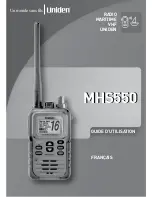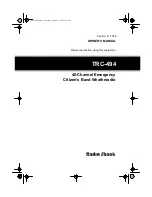
TC-600 Service Manual
12
Figure 2 Receiver Section Configuration
2) The First Mixer
The signal from RF amplifier is mixed with the first local oscillator signal from PLL frequency
synthesizer in the first mixer (Q23) to generate a 45.050MHz first IF signal. The first IF signal is then
fed through two monolithic crystal filters (XF1) to remove spurious signals from adjacent channels.
3) IF Amplifier
The first IF signal is amplified in Q22 and then enters the IF processing chip IC1. The signal is mixed
with the second local oscillator signal in IC1 to create a 455KHz second IF signal. The second IF
signal is then fed to a 455KHz ceramics filter (CF1) to eliminate unwanted signals before it is amplified
and detected in IC1.
4) Audio Amplifier
The demodulated audio signal obtained from IC1 is amplified in IC7 (1/4), and then filtered by low pass
filter Q19 and high pass filter Q20, and then de-emphasized by R130 and C156. The resulting audio
signal passes through a volume control circuit and then is amplified to a sufficient level to drive the
speaker by audio power amplifier (IC8).
5) Squelch
Part of the audio signal from IC1 re-enters IC1, and the noise component is amplified and rectified by a
filter and an amplifier to produce a DC voltage corresponding to the noise level. The DC signal goes to
the analog port of the microprocessor (IC11). IC11 determines whether to output sounds from the
speaker by detecting whether the input voltage is higher or lower than the preset value.
To output sounds from the speaker, IC11 sends a high level signal to the MUTE and AFCO lines and
turns on IC8 through Q12.














































